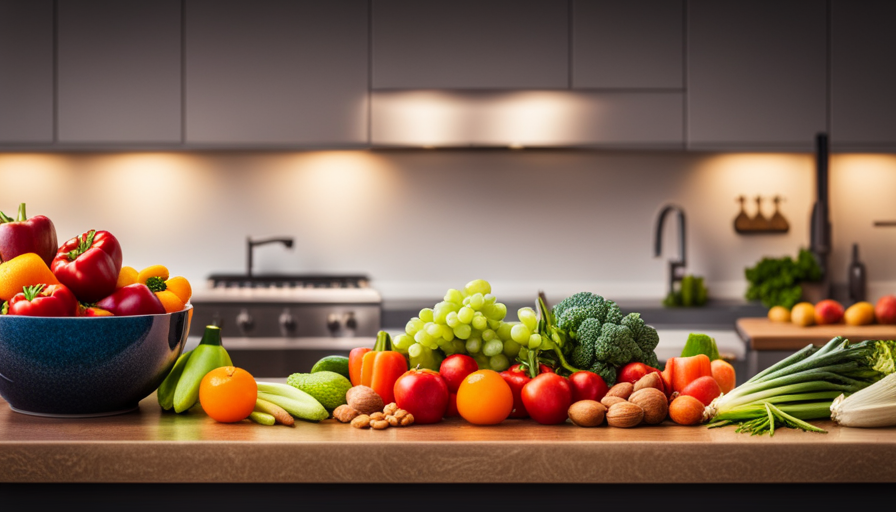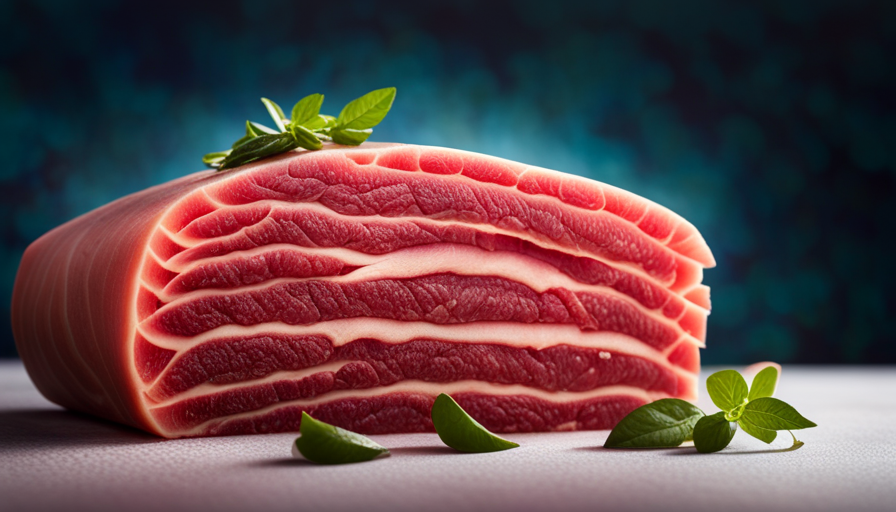Are you prepared to embrace a healthier lifestyle? If you are, consider delving into the realm of raw food. Similar to a ripe and succulent fruit, a raw food diet is full of energy and essential nutrients that can support your overall well-being.
By consuming uncooked and unprocessed foods, you’ll be tapping into the natural goodness of fruits, vegetables, nuts, and seeds. But where do you begin on this raw food adventure? Don’t worry, I’ve got you covered.
In this article, we’ll explore the ins and outs of starting a raw food diet, from understanding the concept to stocking up on essentials and preparing delicious meals. Together, we’ll navigate this mouthwatering journey, and before you know it, you’ll be reaping the benefits of a healthier, more vibrant you.
So, let’s dive in and get started on this raw food odyssey!
Key Takeaways
- Gradually transition into a raw food lifestyle to prevent digestive issues and allow the body to adapt.
- Stock up on raw food essentials like fruits, vegetables, nuts, and seeds.
- Meal planning is essential for a successful raw food diet.
- Educate yourself on raw food nutrition to ensure long-term success.
Understanding the Concept of a Raw Food Diet
If you’re ready to embark on a life-changing journey towards vibrant health and boundless energy, then it’s time to understand the power of a raw food diet. Understanding the benefits of a raw food diet is crucial before diving into this lifestyle.
Many people believe that raw food diets are simply about eating fruits and vegetables in their natural state, but it goes beyond that. Raw food diets emphasize consuming uncooked and minimally processed foods, which retain more nutrients and enzymes than cooked foods.
Raw foods are packed with essential vitamins, minerals, and antioxidants that promote overall health and well-being. They also contain live enzymes that aid digestion and support a healthy immune system. One of the main benefits of a raw food diet is the high nutrient content.
Another benefit is weight management. Raw foods are often lower in calories than cooked foods, making them ideal for those looking to lose or maintain weight.
Now, let’s debunk some common myths surrounding raw food diets. One myth is that raw food diets lack protein. However, there are plenty of plant-based sources of protein, such as nuts, seeds, and legumes, that can easily meet your daily protein needs.
Another myth is that raw food diets are boring and restrictive. On the contrary, there are countless delicious and creative raw food recipes that can satisfy any palate.
To continue your journey towards a raw food diet, it’s important to educate yourself on raw food nutrition.
Educate Yourself on Raw Food Nutrition
To get started on your raw food journey, it’s important to familiarize yourself with the nutritional aspects of this lifestyle, just like a sailor would study the intricate maps before embarking on a voyage. Educating yourself on raw food nutrition will help you understand the benefits and debunk the myths associated with a raw food diet.
-
Raw Food Diet Benefits:
- Improved digestion: Raw foods are rich in enzymes that aid in digestion, leading to better nutrient absorption and reduced bloating.
- Increased energy levels: Raw foods are packed with vitamins, minerals, and antioxidants that provide sustained energy throughout the day.
- Weight management: A raw food diet is naturally low in calories and high in fiber, which can help with weight loss or maintenance.
-
Raw Food Diet Myths:
- Lack of protein: Raw plant-based foods can provide all the essential amino acids needed for protein synthesis.
- Nutrient deficiencies: A well-planned raw food diet can meet all your nutritional needs, including vitamins, minerals, and omega-3 fatty acids.
- Tasteless and boring: Raw food recipes can be creative and delicious, incorporating a variety of fruits, vegetables, nuts, and seeds.
By understanding the benefits and dispelling the myths, you can confidently begin your raw food journey. Start slow and gradually transition into incorporating more raw foods into your diet, allowing your body to adapt to this new way of eating.
Start Slow and Gradually Transition
Before diving headfirst into a raw food lifestyle, it’s important to ease into the transition gradually, allowing your body to adapt to the new way of eating. Starting slow has its benefits.
By gradually incorporating more raw foods into your diet, you give your digestive system time to adjust and become more efficient at breaking down raw fruits, vegetables, nuts, and seeds. This can help prevent any discomfort or digestive issues that may arise from suddenly introducing a high-fiber diet.
A gradual transition also allows you to explore different raw food recipes and find what works best for you. You can experiment with different flavors, textures, and combinations, ensuring that you enjoy your meals and don’t feel deprived. This approach increases the likelihood of long-term success and adherence to a raw food diet.
Additionally, starting slow gives you time to educate yourself on proper nutrition and meal planning for a raw food lifestyle. Understanding the principles of balanced raw food nutrition will help you create a well-rounded and nutrient-dense diet, ensuring you meet your body’s needs.
As you gradually transition to a raw food lifestyle, it’s important to stock up on raw food essentials to make the process easier and more convenient.
Stocking Up on Raw Food Essentials
When embarking on a raw food journey, it’s crucial to ensure your pantry is filled with all the essential ingredients that will make your culinary adventures exciting and delicious. Raw food shopping can be a bit overwhelming at first, but with a well-stocked raw food pantry, you’ll be able to create a wide variety of nutritious and satisfying meals. To help you get started, here is a handy table to guide you on what to stock up on:
| Fruits | Vegetables |
|---|---|
| Apples | Spinach |
| Oranges | Carrots |
| Bananas | Cucumbers |
| Berries | Bell Peppers |
These are just a few examples, but feel free to explore other options and choose fruits and vegetables that you enjoy. Additionally, it’s important to have some staple items such as nuts, seeds, and dried fruits for added texture and flavor in your raw food dishes. Once you have your raw food pantry stocked up, you’ll be ready to start planning and preparing raw food meals that are both nutritious and delicious.
Now, let’s move on to the next section where we will discuss the importance of planning and preparing raw food meals.
Planning and Preparing Raw Food Meals
Now that you’ve stocked up your raw food pantry with all the essentials, get ready to dive into the exciting world of planning and preparing delicious, nutritious meals that’ll leave you craving for more.
Meal planning is an essential part of a successful raw food diet. It helps you stay organized, ensures you have all the necessary ingredients on hand, and allows you to make the most out of your raw food journey.
When it comes to meal planning, it’s important to consider the kitchen equipment you’ll need. Investing in a good quality blender is a must for creating smoothies, sauces, and dressings. A food processor is another handy tool for chopping, slicing, and shredding fruits and vegetables. Additionally, having a dehydrator can help you create tasty snacks like kale chips or fruit leathers.
To make meal planning easier, start by creating a weekly menu. This’ll give you a clear idea of what meals you’ll be having each day and what ingredients you’ll need to have on hand. Make sure to include a variety of fruits, vegetables, nuts, and seeds to ensure you’re getting a good balance of nutrients.
Transitioning to a raw food diet may present some challenges and obstacles, but with proper planning and preparation, you can overcome them and thrive on this exciting culinary journey.
Overcoming Challenges and Obstacles
To truly thrive on this exciting culinary journey, you’ll need to tackle and conquer the challenges and obstacles that come your way. Overcoming mindset barriers is crucial when transitioning to a raw food diet. It’s common to feel overwhelmed or doubt your ability to stick to this lifestyle change. Remember that it’s a process, and with time and practice, it’ll become easier.
-
Stay positive and motivated: Surround yourself with supportive people and engage in activities that inspire you. This’ll help you maintain a positive mindset and stay motivated on your raw food journey.
-
Plan ahead: One of the biggest challenges is maintaining your social life while following a raw food diet. Plan ahead for social gatherings by bringing your own raw food dishes or suggesting raw food-friendly restaurants. This way, you can enjoy the company of others while staying true to your dietary choices.
-
Educate yourself: Knowledge is power. Learn about the benefits of a raw food diet and the science behind it. This’ll help you overcome any doubts or criticisms from others and reinforce your commitment to this lifestyle.
-
Find alternatives: Cravings for cooked or processed foods may arise. Experiment with raw food recipes that mimic the flavors and textures you enjoy. This’ll help you satisfy cravings and stay on track.
By overcoming these challenges and obstacles, you’ll be able to listen to your body and make adjustments as needed in your raw food journey. Remember, it’s all about finding what works best for you and nourishing your body in a way that feels good.
Listening to Your Body and Making Adjustments
Embrace the intuitive whispers of your body, allowing it to be your compass as you navigate your unique culinary journey towards nourishment and fulfillment. When embarking on a raw food diet, it’s important to listen to your body and make adjustments along the way. Your body is constantly sending signals and feedback about what it needs and what works best for you. By paying attention to these cues, you can fine-tune your raw food diet to suit your individual needs.
One way to listen to your body is by keeping a food journal. This can help you identify patterns and make connections between what you eat and how you feel. For example, you may notice that certain foods make you feel energized and vibrant, while others leave you feeling sluggish or bloated. By making adjustments based on these observations, you can optimize your raw food diet to support your overall well-being.
Incorporating a 3 column and 5 row table can help you track your food choices, symptoms, and feelings. Here’s an example:
| Food Choice | Symptoms | Feelings |
|---|---|---|
| Kale salad | Increased energy, improved digestion | Happy, satisfied |
| Banana smoothie | Bloating, stomachache | Tired, uncomfortable |
| Raw nuts | Sustained energy, satisfied hunger | Calm, focused |
By using this table, you can identify trends and make adjustments accordingly. For instance, if you notice that certain foods consistently cause discomfort, you can choose alternatives that provide similar benefits without the negative effects.
Listening to your body and making adjustments is essential for long-term success on a raw food diet. It allows you to fine-tune your choices and create a sustainable and enjoyable eating plan. By paying attention to how different foods make you feel and making adjustments accordingly, you can optimize your health and well-being.
As you continue on your raw food journey, staying motivated and inspired is crucial. [Transition sentence to next section about staying motivated and inspired.]
Staying Motivated and Inspired
When it comes to staying motivated and inspired on a raw food diet, I find that success stories from others who’ve achieved their health goals can be incredibly motivating. Hearing about their transformations and the positive impact that raw food has had on their lives reminds me why I started this journey in the first place.
Additionally, exploring new raw food recipes and techniques keeps the diet exciting and helps me avoid getting bored with my meals. Trying out different flavors and textures keeps things interesting and helps me stay committed to the raw food lifestyle.
Finding inspiration from success stories and community support
Seeking motivation from real-life success stories and the unwavering support of a like-minded community can ignite a fire within, propelling you towards the transformative journey of a raw food diet. Hearing about others who’ve achieved their health goals through raw food can be incredibly inspiring and give you the confidence to push forward.
The raw food community provides a space for sharing experiences, asking questions, and receiving encouragement. Being a part of this supportive network can help you stay motivated and accountable to your own goals. It’s amazing how much inspiration can be found in the stories of others who’ve overcome challenges and achieved success on their raw food journey.
By tapping into this collective wisdom and support, you can stay motivated and inspired to continue on your own path of raw food exploration and growth.
Now, let’s dive into the exciting world of exploring new raw food recipes and techniques to keep the diet exciting.
Exploring new raw food recipes and techniques to keep the diet exciting
After finding inspiration from success stories and receiving support from the raw food community, it’s time to explore new raw food recipes and techniques to keep the diet exciting. Incorporating new raw food ingredients and getting creative with the presentation can make a significant difference in the overall enjoyment of the raw food lifestyle. To provide a visual representation of ideas, I have created a table below showcasing three exciting and delicious recipes that utilize unique raw food ingredients and innovative presentation techniques.
| Recipe Name | Main Ingredients | Presentation Technique |
|---|---|---|
| Zucchini Noodles with Avocado Pesto | Zucchini, Avocado, Basil, Lemon | Spiralized zucchini noodles topped with creamy avocado pesto |
| Raw Vegan Sushi Rolls | Nori Sheets, Cauliflower Rice, Avocado, Carrot, Cucumber | Traditional sushi rolling technique using raw, plant-based ingredients |
| Raw Chocolate Mousse | Avocado, Cacao Powder, Maple Syrup, Vanilla Extract | Smooth and velvety chocolate mousse made from avocado and cacao powder |
By incorporating these new recipes and techniques, the raw food diet can remain exciting and enjoyable. However, it’s also important to consider other aspects of a healthy lifestyle, such as incorporating exercise and self-care.
Incorporating Exercise and Self-Care into Your Raw Food Lifestyle
To truly thrive on a raw food diet, it’s essential to infuse your daily routine with self-care practices and regular exercise, giving your body the love and attention it deserves. Incorporating exercise routines and self-care practices into your raw food lifestyle can provide numerous benefits for both your physical and mental well-being.
When it comes to exercise, finding routines that work for you is key. Whether it’s going for a brisk walk, practicing yoga, or engaging in high-intensity interval training, the goal is to get your body moving and your heart rate up. Regular exercise not only helps to strengthen your muscles and improve your cardiovascular health, but it also boosts your mood and reduces stress.
Self-care practices are equally important. Taking time for yourself each day to relax, unwind, and pamper your body is crucial for maintaining a healthy lifestyle. This can include activities such as meditation, taking a warm bath, practicing deep breathing exercises, or indulging in a soothing massage. Prioritizing self-care allows you to recharge and rejuvenate, ensuring you have the energy and motivation to stick to your raw food diet.
By incorporating exercise and self-care practices into your raw food lifestyle, you’re not only nourishing your body with nutritious foods but also taking care of your overall well-being. Celebrating your progress and enjoying the benefits of this holistic approach will only further motivate you in your journey towards optimal health and vitality.
Celebrating Your Progress and Enjoying the Benefits
After incorporating exercise and self-care into my raw food lifestyle, I’ve noticed significant improvements in my overall well-being. Not only do I feel energized and refreshed, but I’ve also experienced a boost in my mood and mental clarity. It’s amazing how taking care of my body has had such a positive impact on my mind.
Now that I’ve made progress on my raw food journey, it’s important to take a moment to celebrate my achievements and enjoy the benefits of this lifestyle. Here are a few ways I can celebrate my milestones and continue to reap the rewards of a raw food diet:
-
Reflect and appreciate: Take some time to reflect on how far I’ve come and appreciate the positive changes I’ve experienced. Keeping a journal or creating a gratitude list can help me acknowledge and celebrate my progress.
-
Treat myself: Indulge in some raw food treats or create a special raw food meal to celebrate reaching a milestone. Trying out new recipes or visiting a raw food restaurant can be a fun way to reward myself for my dedication.
-
Share with others: Spread the joy and benefits of a raw food diet by sharing my experiences and recipes with friends and family. Hosting a raw food potluck or organizing a cooking class can be a great way to celebrate while also inspiring others to embrace this healthy lifestyle.
By celebrating my progress and enjoying the benefits of a raw food diet, I can stay motivated and continue on this journey towards optimal health and well-being.
Frequently Asked Questions
Can I still eat cooked foods occasionally while following a raw food diet?
Yes, you can still enjoy cooked foods occasionally while following a raw food diet. It’s all about finding a balance that works for you. Incorporating cooked food alternatives can help satisfy cravings and add variety to your meals. However, it’s important to remember that the majority of your diet should consist of raw, unprocessed foods to maximize their nutritional benefits. Experiment with different cooking methods like steaming or lightly sautéing to retain more nutrients.
What are the potential health risks associated with a raw food diet?
When it comes to a raw food diet, it’s important to be aware of the potential risks and health concerns. While this diet can offer many benefits, such as increased nutrient intake and weight loss, there are some things to consider.
One potential risk is the increased risk of foodborne illnesses, as raw foods are not cooked and can harbor harmful bacteria. Additionally, a raw food diet may be deficient in certain nutrients like vitamin B12 and iron.
It’s crucial to consult with a healthcare professional before starting this diet to ensure you’re meeting your nutritional needs.
How can I ensure I am getting all the necessary nutrients on a raw food diet?
Ensuring nutrient balance on a raw food diet requires careful meal planning. It’s important to include a variety of fruits, vegetables, nuts, seeds, and sprouted grains to meet your nutritional needs.
Incorporating foods rich in protein, such as legumes and leafy greens, can help ensure you’re getting enough of this essential nutrient.
Additionally, it’s recommended to supplement with vitamin B12, as it’s mainly found in animal products.
Consulting with a registered dietitian can provide personalized guidance for a well-rounded raw food diet.
Are there any specific kitchen tools or equipment that are essential for preparing raw food meals?
When it comes to preparing raw food meals, there are a few essential kitchen tools that can make the process much easier and more efficient. A good quality blender is a must-have for creating smoothies, sauces, and dressings.
A food processor can be used for chopping, shredding, and mixing ingredients.
Additionally, a high-speed juicer is great for extracting fresh juices from fruits and vegetables.
These tools will help you whip up delicious raw food meals in no time.
Can I eat out at restaurants while following a raw food diet, and if so, what are some tips for navigating the menu?
Yes, you can eat out at restaurants while following a raw food diet. When dining at social events or non-raw restaurants, it’s important to navigate the menu wisely.
Look for options like salads, vegetable dishes, and fresh fruit. You can also ask the server if they can accommodate your raw food preferences.
It’s helpful to plan ahead and research restaurants that offer raw food options. Remember to communicate your dietary needs and be open to making modifications to ensure you stay true to your raw food lifestyle.
Can I Use Raw Meat in a Raw Food Diet?
When following a raw food diet, cooking raw meat in Witcher 3 is not recommended. Raw meat can carry harmful bacteria and parasites that may cause illness if consumed. It’s best to stick to safe alternatives like raw fruits, vegetables, nuts, and seeds for a healthier approach to the raw food diet.
Conclusion
In conclusion, embarking on a raw food diet can be a transformative journey that requires dedication and a willingness to explore new tastes and textures.
By understanding the concept of raw food nutrition and gradually transitioning into this lifestyle, you can reap the numerous health benefits that come with it.
It’s important to stock up on raw food essentials, plan and prepare your meals, listen to your body’s needs, and stay motivated throughout your journey.
Remember to incorporate exercise and self-care, celebrate your progress, and enjoy the incredible benefits of a raw food lifestyle.










